...and diagrams
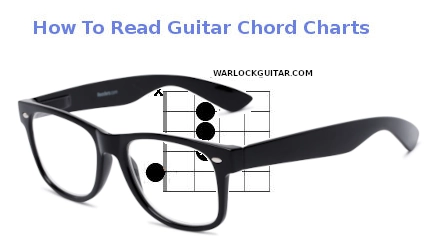
Learning how to read guitar chord charts can be confusing for beginners due to the many different styles of diagrams used in books, posters and on the Internet. So many in fact that it can get confusing trying to understand what's what. The cause of so many different styles of chord diagrams is due to the plethora of information that can be conveyed. Since there is no set standard as to how chord charts are drawn, I thought it would be a good idea to write an article about how to read the most common elements and symbols used in most diagrams.
First I'll explain the types of diagrams I use (see guitar chord chart for an example). Then I'll go over some of the many variations you are likely to see out in the wild.
What are guitar chord charts?
Chord charts are visual representations of guitar chords that show you the notes you are to play.
The chord charts in this lesson
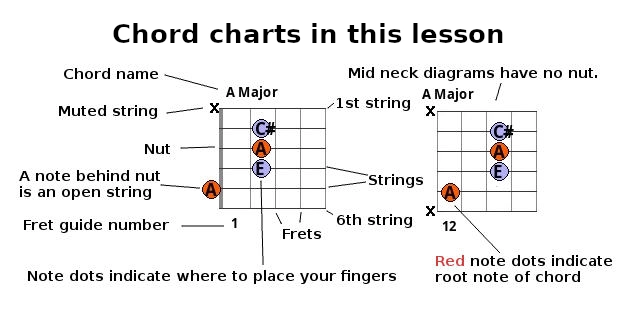
Most chord charts are oreinted for right handed players because they are the majority. Charts are positioned as if the neck of the guitar is laying on your lap in the same direction as your normal right hand playing direction. I do this because it is the most logical way to look at the guitar. It's same as if you are holding the guitar for play and looking downward. Symbols I use * The dots show the note names that make up the chord. * I don't show fingering at all because I assume that the player will figure out the fingering that suits him or her the best. * Charts with a thicker line on the left indicate the guitar's nut. Nuts show up on diagrams where at least one note of the chord is an open string. * Diagrams with no nut are used for all other mid neck charts. * Notes of open strings or any note/dot on the non fret side of the nut. * Red filled dot color indicates root notes of the chord while blue filled indicates the other notes. * An X indicates a string that is not to be played. * Fret guide numbers tell you what position the chord is in.
Other types of chord chart layouts
Here are a few other chord chart layouts you are likely to see used in books and around the Internet.
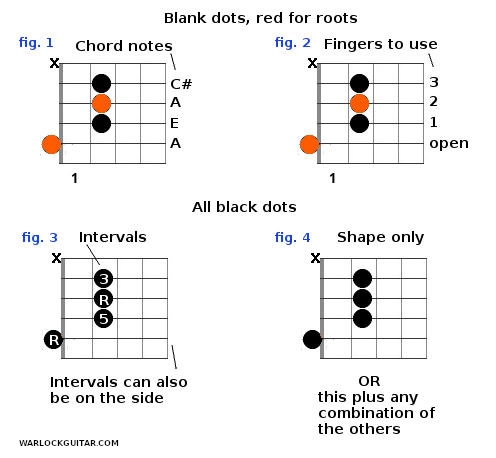
The dots can show fingering or note names or can be solid colors (usually black like fig. 4). Notes and fingering can also be shown on the side (fig.1 and 2). Open strings can be any note/dot on the non fret side of the nut. However, hollowed out dots are also used to indicate notes of open strings ( seen an example of this further down under charts for sheet music and TAB).
Dots with a red fill color usually indicate root notes. Dots can have numbers to indicate intervals and an "R' to indicate roots (fig. 3).
Vertical chord charts
You'll also see many chord charts in the vertical position. Vertical chord charts are situated as if you were holding the guitar out in front and facing you. If you were to follow the arrow in the picture below, it would lead you to the body of the guitar.
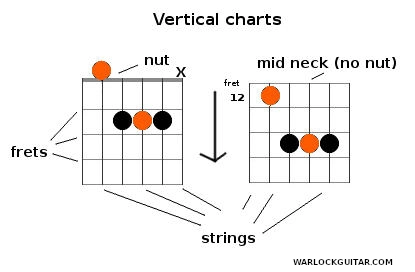
You'll also see various combinations of colored dots, dots with notes and dots with finger numbers on vertical charts.
Chord charts in sheet music or TAB
Guitar chord charts over the staff in sheet music or TAB are almost always the vertical type. They are pretty small too. Notice the open notes are hollow and not solid filled.
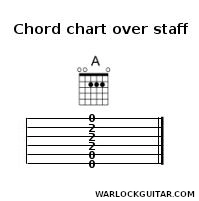
Blank Guitar chord chart paper
You might find yourself needing to write down some chord charts. Coloring in chord charts with dots and notes can be great practice. Head on over to blank chord chart paper to print your own blank sheets. (See below for left handed paper)
Left handed guitar charts
I know it's not fair to you lefties out there but most the chord charts you will ever come across are for right handed guitarists. As a left handed player, you are going to have to adapt and transpose right hand diagrams of the songs you like. The good news is, all that transposing will make you smarter! I encourage you to do it as much as you can. You will be a better guitarist because of it. I made some printable left handed guitar chord chart paper to get you started.